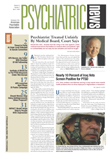Maine's program to reduce the number of youth suicides received a federal shot in the arm in February in the form a $300,000 three-year joint grant from the Centers for Disease Control and Prevention (CDC) and the Substance Abuse and Mental Health Services Administration (SAMHSA).
The grant will fund an assessment of school-based suicide-prevention programs with and without a community-based component, according to the CDC. The funds will also help Maine evaluate efforts to lower its youth suicide rate, which is higher than the national average. The evaluation also will assist state officials in deciding how best to disburse an earlier $1.2 million from SAMHSA for suicide prevention in youth.
Between 1998 and 2002, the suicide rate among Maine youth was 25 percent above the national average, the 17th highest in the country, and the second highest in New England, according to the CDC.
The suicide rate, state officials said, reflects in part the rural nature of Maine. Nationally, suicide rates are approximately one-third higher in rural areas than in core metro areas.
In small rural states like Maine where youth-suicide rates are high, most communities feel the impact of the problem, with families, friends, and community members confronting the trauma that follows a youth's suicide, according to the Maine Youth Suicide Prevention Program (MYSPP).
Jack Nicholas, commissioner of the Maine Department of Health and Human Services, said in a statement that the SAMHSA grant will allow implementation of the state's newest suicide-prevention plan in three more Maine counties: Knox, Piscataquis, and Sagadahoc.
“Our efforts are leading the country in reaching out to prevent teen suicide,” said Gov. John Baldacci in a statement.
Among the new goals of the MYSPP is “strengthening efforts to include high-risk and particularly vulnerable communities and culturally sensitive populations in planning and implementing program components,” according to the MYSPP's December 2005 report.
State officials reported that there were 805 suicides in Maine from 1999 through 2003, which included 106 suicides among youth aged 8 to 24. More people in that age group in the state die from suicide than from homicide, with five to six suicides among 15- to 24-year-olds for every homicide.
Nationally, the rate of suicide among youth has declined slowly since 1992. Federal officials said, however, that few schools and communities have suicide-prevention plans that include screening, referral, and crisis-intervention programs for youth, despite the fact that suicide is the third leading cause of death among people aged 15 to 24. In 2001, 3,971 suicides were reported in this group nationwide.
Also selected to receive $100,000 grants to implement suicide-prevention programs and conduct evaluations for three years were the Tennessee Department of Mental Health and the Native American Rehabilitation Association of Oregon. The programs were chosen from 11 applicants because federal officials“ believed these three had the most potential to add to what we know works in youth suicide, especially on the community level,” Keri Lubell, Ph.D., a CDC behavioral scientist, told Psychiatric News.
The most recent report of the MYSPP is posted at<www.state.me.us/suicide/prreport106.htm>.▪
